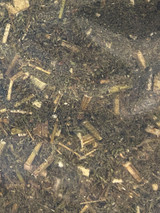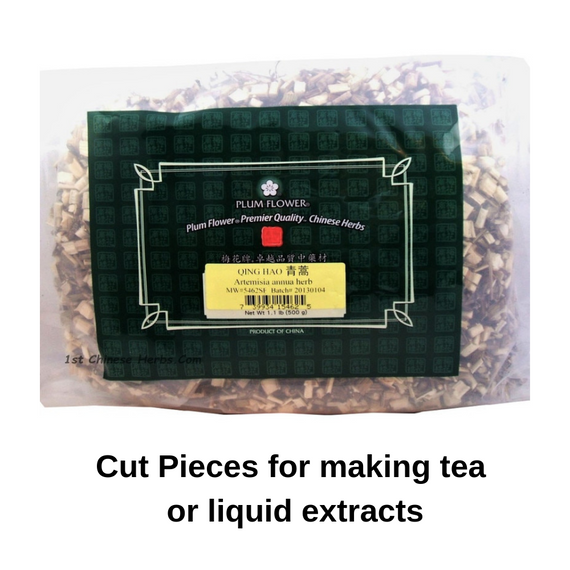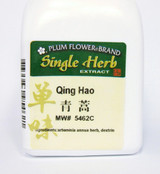Herbal information on Organic Artemisia Annua in Bulk Cut Form
Qing Hao (Artemisia Annua) in Traditional Chinese Medicine (TCM)
Qing Hao (青蒿), also known as Artemisia Annua or Sweet Wormwood, is a prominent herb in Traditional Chinese Medicine (TCM). It has been used for centuries in China for its medicinal properties and has garnered international attention for its role in treating malaria. Qing Hao (Ching-hao) was described in the Shennong Bencao Jing (*) where it was listed as caohao: Caohao is bitter and cold. It mainly treats skin bugs, itchy scabs, and malign sores; it kills lice, relieves lodged heat in the joints, and brightens the eyes. Its other name is qinghao."
Stephen Buhner wrote a book called "Healing Lyme Disease" where he details the properties of this herb and how Qing Hao is benefical to people who have Lyme Disease.

Health Benefits Of Qing Hao - Artemisia Annua in Traditional Chinese Medicine
-
Clearing Heat and Dampness:
- Indications: Qing Hao is traditionally used to clear heat from the body, especially during fever or summer heatstroke. It addresses heat in the yin aspect of the body, which is associated with internal organs and deep physiological processes.
- TCM Theory: It enters the Liver, Gallbladder, and Kidney meridians, cooling the blood and reducing symptoms of heat such as fever and night sweats.
-
Treating Malaria and Fevers:
- Indications: Artemisinin, derived from Qing Hao, is a powerful treatment for malaria. In TCM, Qing Hao is used to treat malaria-like symptoms, including recurrent fevers and chills.
- TCM Theory: It is known for its ability to resolve intermittent fever and is considered effective in treating both the symptomatic fever and the underlying cause.
-
Alleviating Jaundice:
- Indications: It is used for jaundice due to liver and gallbladder issues, helping to relieve symptoms by promoting bile flow and detoxification.
- TCM Theory: By clearing damp-heat, Qing Hao helps the body expel excess heat and toxins that contribute to jaundice.
-
Addressing Skin Disorders:
- Indications: It can be applied externally to treat eczema, psoriasis, and other skin inflammations.
- TCM Theory: The herb’s cooling properties help soothe the skin and reduce inflammation.
-
Promoting Immunity and Overall Health:
- Indications: Its antimicrobial and anti-inflammatory properties support the immune system, making it useful for general health maintenance and preventing infections.
- TCM Theory: Qing Hao's ability to clear heat and detoxify supports the body's natural defenses.
Lyme Disease
Qing Hao (Artemisia Annua) is gaining attention for its potential benefits in treating Lyme disease, a complex illness caused by the bacterium Borrelia burgdorferi. Research studies state how it may help:
Antimicrobial Properties
Qing Hao contains compounds like artemisinin, which have demonstrated broad-spectrum antimicrobial effects. These compounds can inhibit the growth of various pathogens, including bacteria responsible for Lyme disease. Research suggests that Qing Hao’s antimicrobial properties may help reduce the bacterial load in Lyme disease patients, potentially alleviating symptoms.
Anti-Inflammatory Effects
Lyme disease often leads to significant inflammation, causing joint pain, fatigue, and neurological issues. Qing Hao has anti-inflammatory properties that may help reduce inflammation throughout the body. By mitigating inflammation, Qing Hao can potentially ease pain and improve overall well-being in individuals with Lyme disease.
Immune System Support
Qing Hao may help modulate the immune system, enhancing its ability to fight off infections. Lyme disease can impair immune function, making it harder for the body to combat the bacteria. Qing Hao's immunomodulatory effects can strengthen the body's natural defenses, promoting a more effective response to the infection.
Neuroprotective Benefits
One of the serious complications of Lyme disease is neurological damage. Some studies suggest that Qing Hao has neuroprotective properties, which can help protect nerve cells from damage and support neurological health. This is particularly important for Lyme disease patients experiencing cognitive symptoms or neurological complications.
Detoxification Support
Lyme disease and its treatment can lead to a buildup of toxins in the body. Qing Hao has been traditionally used to support liver function and detoxification processes. By promoting detoxification, it may help alleviate some symptoms associated with toxin buildup, such as fatigue and muscle pain.
Potential for Synergy with Conventional Treatments
Qing Hao can be used alongside conventional antibiotics to enhance their effectiveness. Some studies suggest that the herb’s compounds may enhance the efficacy of antibiotics, helping to clear infections more effectively and reduce the risk of antibiotic resistance.
Common Name: Sweet Wormwood
Botanical Name: Artemisia Annua
Channels: Kidney, Liver
Other Names: Herba Artemisiae Annuae, Sweet Wormwood, Sweet Sagewort
Pin Yin Name: Qing Hao, Ching Hao
Other Ingredients: No fillers or excipient
Package Size: 1 pound
Form: Cut
Brand: Nuherbs Organic Herbs
Origin: China
Cautions: Do not use if pregnant or nursing. Should not be boiled for a long time.
Naturally Occurring Components
- Artemisinol
- Palmitic acid
- Coumarin
- Octacosanol
- β-Sitosterol
- Myrcene
- Sesquiterpenes
- Flavonoids
- Artemetin
- Borneol
Proprties: Bitter, Cold
California Prop 65
Summary of Artemisia Annua Qing Hao
- A Traditional Chinese Herb used by Traditional Chinese Herbalists.
- Sweet wormwood, an herb from the Far East, used for centuries in China for addressing specific microbial imbalances.
- Artemisia Annua is being studied on its efficacy on fighting Malaria disorders.
- Benefits Digestion
- May be used topically on skin eruptions
- Main active ingredient is Artemisinin
- Doctors recommend Artemisia annua as a parasite cleanse
What herbs can be combined with Artemisia annua?
+Honeysuckle and Artemisia annua
+Pau d Arco and Artemisia annua
+Raw Rehmannia and Artemisia annua
+Moutan Root and Artemisia annua
How to Use Bulk Herbs Chart
With so many different ways to use bulk herbs, it is easy to get confused. In order to understand how to use the different parts of the plant, please see our informational chart below. We also have several helpful pages if you need additional information. Check out our How to Use Bulk Herbs page to see how to use herbs correctly.
About Nuherbs Lab Tested Quality
Each batch of herbs is dual-lab tested by our in-house lab and independent third party lab. Our in-house lab is equipped with instruments such as a high performance liquid chromatography, moisture determination meter, Fourier transform infrared spectrometer, atomic absorption spectrophotometer, gas chromatograph, etc.
In addition, the following additional tests are performed:
- Micro bacteria
- Pesticides - over 200 pesticides tested for (Uab 2000 screen).
- Heavy Metals - Lead, Mercury and Arsenic
Traditional Chinese Herbs
Chinese herbs encompasses the use of different parts of plants, such as the leaves, roots, stems, flowers, and seeds. These plant parts are often used as a tea, decoctions, extracts, made into capsules or even a footbath. These bulk herbs should be regarded as an added feature to modern western healthcare, and not as a replacement. Chinese traditional herbs ( Teas ) emphasize harmony and balance.
We encourage you to educate yourself on herbs and supplements, by researching reputable sites, and books. Having an open discussion with your physician on what will be most beneficial for your health issues. And lastly discussing interaction of herbs and pharmaceuticals with your pharmacist or physician.
References
http://www.ncbi.nlm.nih.gov/pmc/articles/PMC1885105/
https://www.americandragon.com/Individualherbsupdate/QingHao.html
http://trstmh.oxfordjournals.org/content/100/6/505.short
https://pubmed.ncbi.nlm.nih.gov/16566952/
http://www.itmonline.org/arts/chinghao.htm *
https://en.wikipedia.org/wiki/Artemisia_annua
Hsu HY and Hsu CS, Commonly Used Chinese Herb Formulas with Illustrations, 1980, Oriental Healing Arts Institute, Long Beach, CA.
Barradell LB and Fitton A, Artesunate: A review of its pharmacology and therapeutic efficacy in the treatment of malaria, Drugs 1995; 50(4): 714-741.
2 Reviews
-
Artemisia annua
I love this artemisia annua tea, it is of the best quality and so good for you! It arrived quickly and I am so glad I found this!!
-
Artemisia annua
I love this artemisia annua tea, it is of the best quality and so good for you! It arrived quickly and I am so glad I found this!!




















